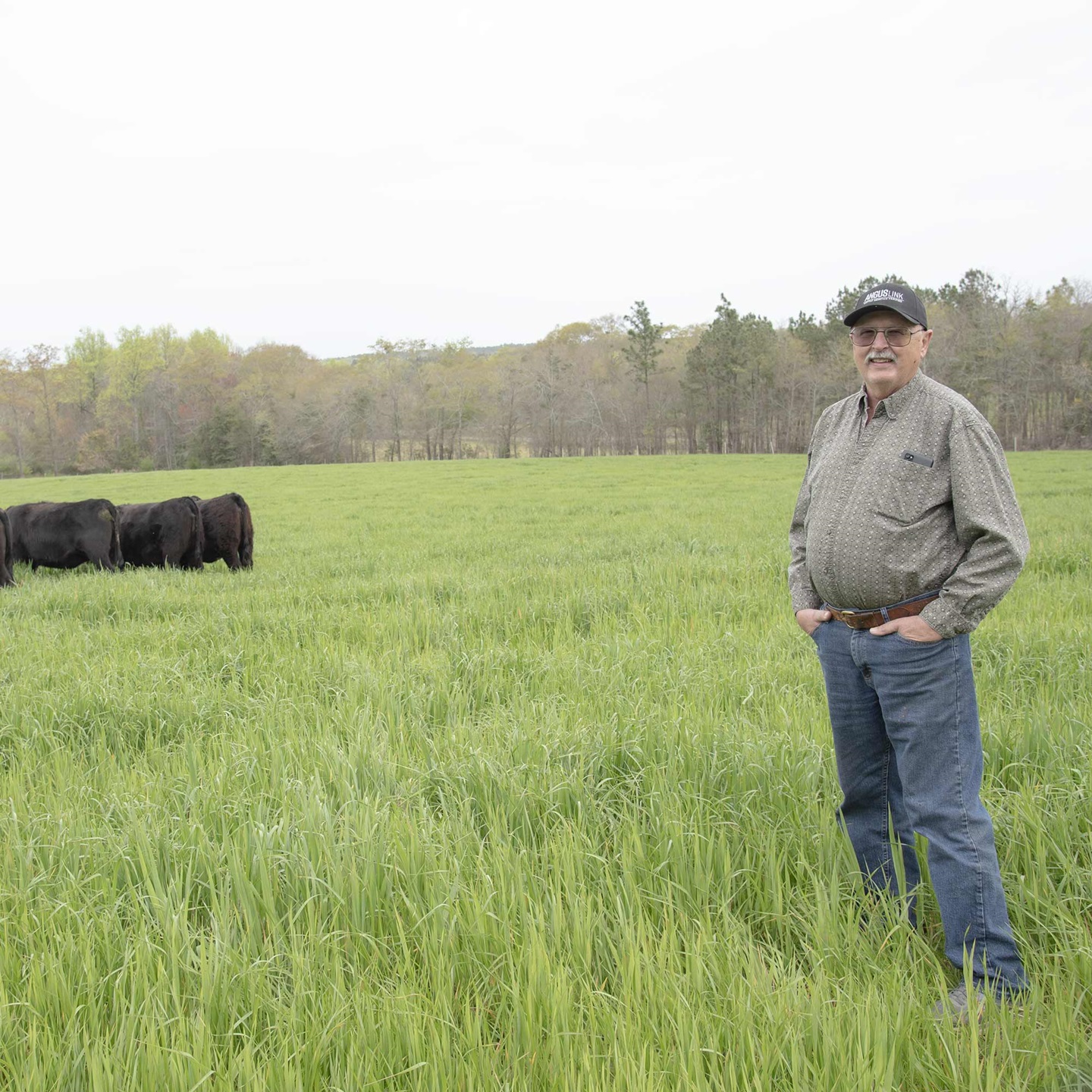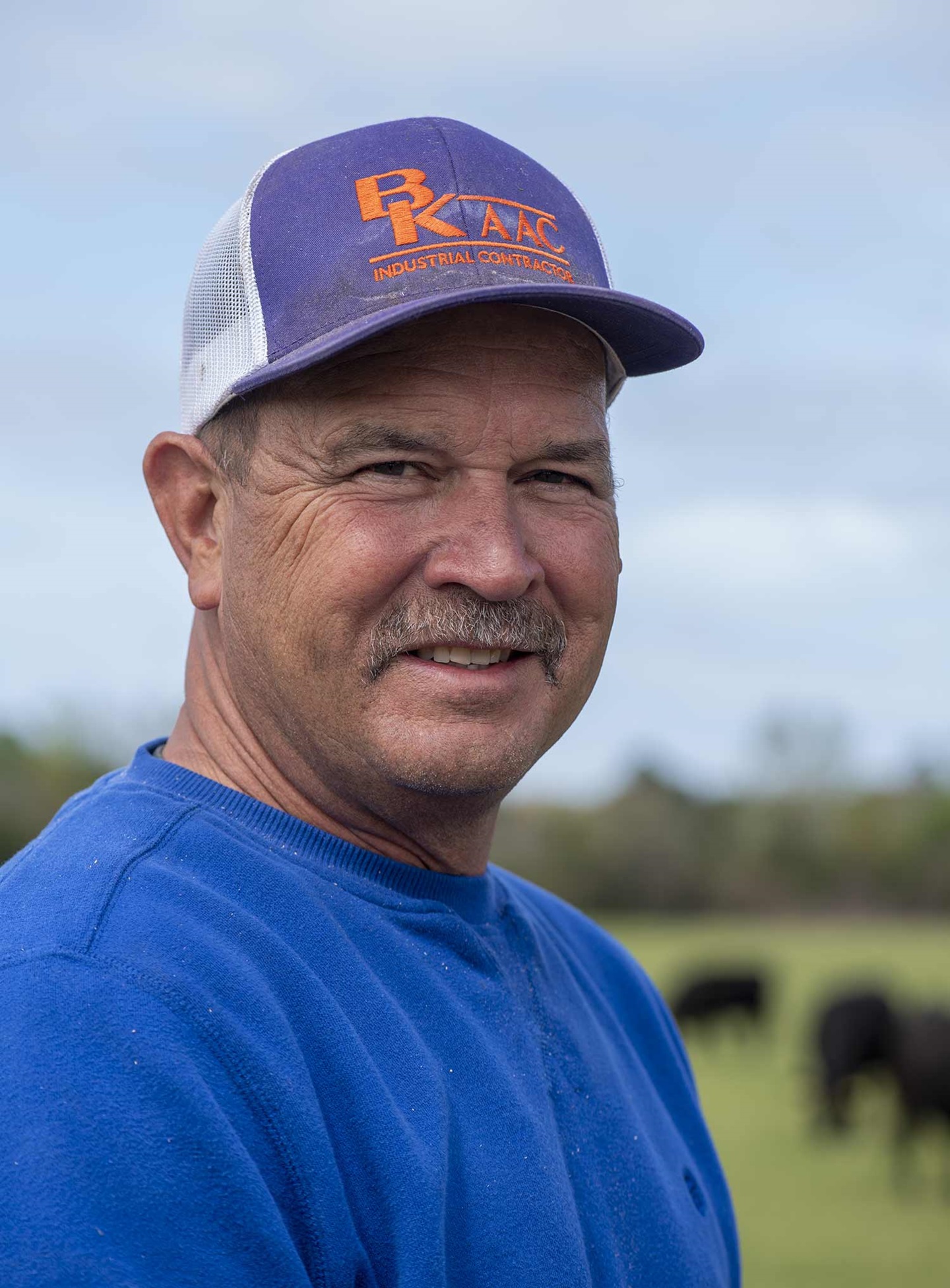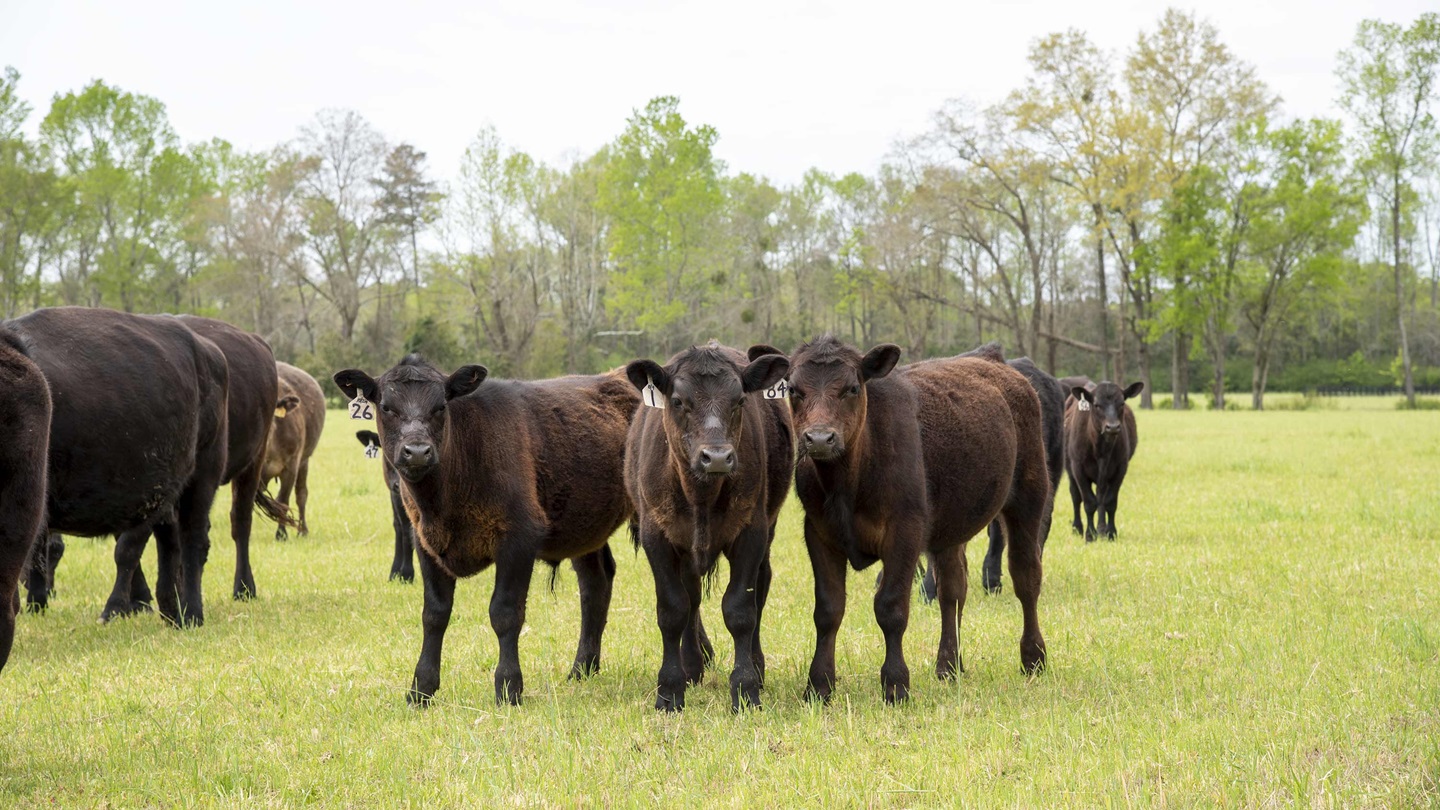People & Programs Pay
Grouping calves with proven certifications adds to producers’ bottom lines.
June 2, 2024
‘In all my years, I never thought about getting cows,” says Terry Kirkland, reflecting on the day his father-in-law, Gene Spence, asked him to take over his cow herd in 1996. A 48-year veteran of the railroad business, Kirkland said yes.
“He lived until 2000,” he adds. “I had to cram a lot into four years.”
It turns out the fledgling producer needn’t have worried. One of the many things he did right was join the Saluda County Cattlemen’s Association (SCCA), now close to 50 years old. Kirkland instantly acquired a club full of mentors.
“Phil (retired county agent Phil Perry) took me right in. There were a lot of older people who were willing to help us, and the whole group was willing to share their knowledge,” Kirkland says.
It wasn’t all talk, either, but heavy doses of leading by example. When Kirkland first consigned heifers to the SCCA annual heifer sale, now in its 32nd year, he says, “I realized real quick where I needed to be with my cattle. It makes you improve.”
Members of the SCCA also coached him through the progression of selling unweaned calves at the stockyard to marketing a truckload lot of preconditioned calves straight off the farm.
Step by step
The first step for the 120-cow Angus-based herd was putting the required preconditioning program in place.
“It is a lot of extra work. You need a good place to hold ’em and good facilities to vaccinate ’em,” he says.
Thankfully, his working facilities are up to speed, and with help from son-in-law Ryan Mayo, they’re able to vaccinate and deworm 100 calves in two hours.
Even with its challenges, preconditioning has its rewards, he says. “I feel like I’m adding value to my calves. You’ve got to do that. When I first started, I figured it took $350 to support a cow for a year. Now it’s tripled.”
He says the margins can be tight, however. Using a rule of thumb of 7 pounds (lb.) of feed per 1 lb. of gain, he figures $1.40 in feed costs alone per pound of gain, along with the expense of homegrown free-choice high-quality ‘Coastal’ Bermuda hay and grazing. It also doesn’t count the added expense of vaccinations and deworming.
Preconditioning pays
When his 800-lb. calves were bringing $1.65 per lb., it was close; but now they’re bringing $2.65 per lb. Plus, even with a 2% pencil shrink at selling time, he says it beats the actual shrink he’d get when he’d take his unweaned calves to the stockyard.
“They’d lose 30 pounds between the time I took ’em and the time they sold,” he recalls. “I just hated to take a baby calf to the stockyard. Now I like watching them grow.”
Grow, they do. Even though he says he doesn’t push them, between the time he weans on May 1 and sells the first week of August, they gain 2-3 lb. per day. That puts his heifers at around 700 lb. and his steers at 750-800 lb. That gives him enough cattle for a truckload of his own, as well as a few extra to place with cattle from other SCCA members to make up more uniform truckloads.

Terry Kirkland
“I encourage more people to precondition,” Kirkland says. “I’ve invested all that money in a cow, why let somebody else make all the money on the calf?”
“I encourage more people to precondition,” Kirkland says. “I’ve invested all that money in a cow, why let somebody else make all the money on the calf?” However, he adds, “You’ve got to have good genetics so you’ll have a calf that grows. There’s no need to feed one otherwise. You’re wasting your money.”
Joey Greene is another SCCA member who believes in preconditioning. He feeds homegrown corn and oats, ‘Coastal’ Bermuda hay and grazing, and purchased corn gluten, soy hulls and whole cottonseed.
“With the price of calves, it is paying for itself,” he says. When he weans the calves from his 80-cow Angus-based herd, they average around 675 lb. After gaining 3.5 lb. a day, they average 830 lb. at sale time.
Location, location
Kirkland, Greene and the other members of SCCA made another major change five years ago. In the late 1960s and early 1970s, they started with a graded calf sale at the stockyard. That evolved into producers bringing their preconditioned calves to the sale barn the day of the sale. There, stockyard workers sorted the calves by frame, type, weight and sex so they could be marketed in uniform truckload lots.
While that meant the producers got higher prices by selling in truckloads, it also meant more stress, shrink and the possibility of the calves getting sick, even though they were preconditioned and vaccinated.
“Because of biosecurity and herd health reasons, all-natural buyers didn’t want cattle that had gone through a sale barn,” says Travis Mitchell, Clemson University Cooperative Extension area and livestock and forages agent.
“As an extension agent who was supposed to be doing my job for producers, it didn’t make sense to me to bring over a thousand head of cattle into one facility and commingle them on the hottest day of the year,” he says. “Some of those calves would arrive at 7 a.m. and didn’t get weighed until 3 or 4 p.m. Our producers didn’t understand what they were giving up in shrink. So, we decided to make the move and start making as many loads as we could off the farms. That’s when we switched marketing from Saluda Livestock Market to Mid-Atlantic Cattle Sales (MACS).”
If a producer doesn’t have the facilities to load a semi, or can’t use a neighbor’s, he or she can take their calves to the spick-and-span barn the SCCA built for livestock shows and sales.
Mitchell, who has been in the Saluda extension office since 2013, and who markets his own cattle with the Saluda group, says his years of helping stockyard workers sort the cattle have given him a leg up.
“By the time we got to this point in 2018 and 2019, we knew our producers’ cattle and knew where the cattle fit,” he says. “It gave us a really good blueprint to go out on these farms and make sense. It would have been much more difficult to make loads with multiple producers from scratch.”
His job is also less challenging because the participating producers are on the same breeding and calving seasons and have similar genetics.
Mitchell says the payoff for the extra work from both him and the producers is around 40¢ per lb. over single-head sales through an auction barn.
Added-value programs do their job
When members of the Saluda County Cattlemen’s Association (SCCA) switched from marketing their commingled calves through the local sale barn to marketing the majority off the farm, they started investing in third-party-verified value-added programs. These include IMI Global Beef Care, Global Animal Partnership (GAP), age- and source-verification (ASV), non-hormone treated cattle (NHTC) and the AngusLinkSM AngusVerifiedSM and Genetic Merit ScorecardSM programs.
Troy Marshall, director of commercial industry relations for the American Angus Association, says the programs are a paying proposition. “It’s exciting when you look at overall prices up 30% to 40% and then add the premiums for AngusVerified. We’ve never seen them that high.”
During the last year, the AngusVerified program was responsible for an average of $12 per hundredweight (cwt.) on a six-weight calf, or $74 per head, he says. “That’s just for the AngusVerified.”
Batesburg, S.C., cattleman Terry Kirkland says, “We try to pack on as much as we can with certifications. It is a lot of hoops to jump through, but this is the fifth year, and it gets easier.”
Kirkland says he is grateful to David Gazda, American Angus Association regional manager, for helping him navigate the certification programs. Then there is the bottom line. “AngusLink attracts more bidders — we’ve had as many as 10 wanting our cattle.”
Joey Greene, Jackson, S.C., producer, says, “There are a bunch of interviews and paperwork. They even look at our mineral tags and the receipts from the soy hulls and corn gluten.”
He also says programs like IMI Global Beef Care and GAP are pricey and can cost more than $1,000 each. However, he holds down costs by splitting them with his brother, Junie, since they market their cattle together. The other good news is AngusLink is free if a producer is already enrolled in ASV.
There’s also the more attractive bottom line. When asked to estimate the price difference between single-head sales at a stockyard and uniform truckload lots of quality cattle with programs in place, Travis Mitchell, Clemson University Cooperative Extension livestock and forages agent, says, “Forty cents a pound would be a conservative estimate.”
“That’s being conservative,” he notes.
People factor
While the preconditioning and marketing programs do pay, Kirkland still says people count, too. There is Angus breeder Kevin Yon, who’s coached Greene on forage production, as well as cattle; and Mitchell, who brings in a stellar lineup of speakers at the SCCA meetings in addition to doing the lion’s share of the leg, phone and computer work involved in putting the producers’ cattle in uniform lots.
“Cow people will help you,” says Kirkland, noting that particularly applies to his mentors in the SCCA. “If you don’t have but 30 cows, if you get in the Saluda Association, you’ll come out ahead.”
Editor’s note: Becky Mills is a freelance writer and cattlewoman from Cuthbert, Ga.

Joey Greene

Joey Greene says that black cattle bring more at sale time.
Why Angus?
While Terry Kirkland and Joey Greene are sold on marketing their calves with other members of the Saluda County Cattlemen’s Association (SCCA), they’re also believers in using Angus bulls.
“If you buy a good Angus bull, you can market the calves,” says Kirkland, a Batesburg, S.C., cattleman. “We buy the best bulls we can afford. I used to have Brangus. The buyers would dock you; it didn’t matter how good the calves were.”
Now, he understands the buyers’ insistence on Angus. Recently, he got the carcass data back on a truckload of his Angus-sired steers and says, “We had 57% Prime. I was blowed apart. With Angus, it’s a true thing. They marble and make good carcasses.”
Kirkland also appreciates the Angus influence in his replacement heifers, both the ones he keeps and the ones he sells through the SCCA replacement heifer sale. “We’ve been selling heifers since 2000,” he reports. He says the premiums for his black and black-baldie heifers have made him a loyal consignor.
As for the ones he keeps, he says, “With Angus, I know what I’m getting with EPDs (expected progeny differences). I breed for 1,200- to 1,300-pound cows. They’ll grow you a good calf, and I have kept them at that weight. With EPDs, you can control things like that.”
For Greene, the Angus birth weight and calving-ease EPDs are a big draw. Before he retired, he was working 10 hours a day at the Savannah River Site nuclear plant and helping his late father, James Cecil Greene Jr., with his cow herd.
“Years ago, Daddy bought a high-birth-weight Simmental bull. We had calving problems,” he says. “That’s why I went with Angus with low-birth-weight EPDs. Now, I’m not having to lose mamas or babies.”
He adds, “Black cattle bring more.”
Kirkland agrees, “Angus sells.”
Topics: Feeder-Calf Marketing Guide , Marketing , Management , Success Stories
Publication: Angus Beef Bulletin



